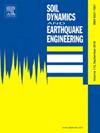Comparison of impounded water models for nonlinear seismic response analysis of arch dam: A case study
IF 4.2
2区 工程技术
Q1 ENGINEERING, GEOLOGICAL
引用次数: 0
Abstract
Simulating impounded water is a crucial aspect of the nonlinear earthquake response analysis of arch dams. This study investigates the impact of impounded water models on the nonlinear dynamic response of arch dams. Three models are considered: the Westergaard added mass model, the compressible impounded water model with rigorous dam-water-foundation interaction, and the compressible water with an approximate water-foundation interaction modeled using the absorption coefficient. The nonlinear dynamic response of the 235 m-high GX arch dam under various earthquake scenarios is analyzed as a numerical example. Concrete damage and contraction joint opening are compared across the three impounded water models. Additionally, the effect of bottom sediment is investigated by simulating it as a liquid. Results indicate that the effect of water compressibility varies from record to record. In extremely strong earthquake scenarios, water compressibility causes the dam concrete damage to shift to lower elevations compared to the added mass model. The model using the approximate absorption coefficient does not adequately capture the water-foundation interaction, while bottom sediment can be neglected when modeled as a liquid.
拱坝非线性地震反应分析的蓄水模型比较——以实例为例
模拟蓄水是拱坝非线性地震反应分析的一个重要方面。研究了蓄水模型对拱坝非线性动力响应的影响。考虑了三种模型:Westergaard加质量模型、具有严格坝-水-地基相互作用的可压缩蓄水模型和采用吸收系数模拟的具有近似水-地基相互作用的可压缩水模型。作为数值算例,分析了235 m高GX拱坝在不同地震情景下的非线性动力响应。比较了三种蓄水模型的混凝土损伤和收缩缝张开情况。此外,通过将底沉积物模拟为液体来研究底沉积物的影响。结果表明,水的压缩性对不同记录的影响是不同的。在极端强烈的地震情况下,水的压缩性导致大坝混凝土损伤向较低海拔转移,而不是增加质量模型。采用近似吸收系数的模型不能充分反映水-地基的相互作用,而将底泥作为液体建模时可以忽略。
本文章由计算机程序翻译,如有差异,请以英文原文为准。
求助全文
约1分钟内获得全文
求助全文
来源期刊

Soil Dynamics and Earthquake Engineering
工程技术-地球科学综合
CiteScore
7.50
自引率
15.00%
发文量
446
审稿时长
8 months
期刊介绍:
The journal aims to encourage and enhance the role of mechanics and other disciplines as they relate to earthquake engineering by providing opportunities for the publication of the work of applied mathematicians, engineers and other applied scientists involved in solving problems closely related to the field of earthquake engineering and geotechnical earthquake engineering.
Emphasis is placed on new concepts and techniques, but case histories will also be published if they enhance the presentation and understanding of new technical concepts.
 求助内容:
求助内容: 应助结果提醒方式:
应助结果提醒方式:


